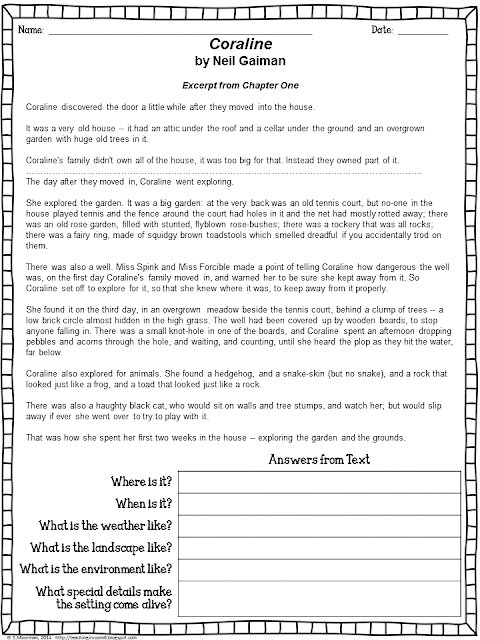Usually, I just point out the time and the place, we talk about it orally, and that is enough. But now, with Common Core and the push to find evidence for everything (since they will have to write about it on the state test at the end of the year), I have taken my lessons on setting up a notch.
We start with a basic anchor chart. This serves as our introduction and also as a handy reference for later on, when the going gets a bit tougher ;) The students take notes in their journals and we discuss. No big deal and the kids seem to get the idea that setting is the time and place the story action occurs. They also understand that it can be the landscape or environment of a story, and that weather and other features can play a part.
The next day, once that has sunk in, I ask the kids to read a short excerpt from a story containing some key elements of setting. There are SO many picture books that are good for this, but we used a short excerpt from Coraline


Then, the students had to actually cite the text with direct quotes or paraphrasing, justifying WHY they included every portion of the picture. Why is there a grey building? Why are there living things on every square inch of the drawing? Why is the palace so sharp looking?
Next, it came time to write about it all. First the students did a little prewriting organizer to get evidence from the text and their own ideas about where and when the story was taking place. I then gave the students a nice paragraph frame (just like Paragraph of the Week...this thing is coming in SO handy!!) and the students set to work constructing a paragraph, using evidence and direct quotes, to describe the setting of the book.
Next, it came time to write about it all. First the students did a little prewriting organizer to get evidence from the text and their own ideas about where and when the story was taking place. I then gave the students a nice paragraph frame (just like Paragraph of the Week...this thing is coming in SO handy!!) and the students set to work constructing a paragraph, using evidence and direct quotes, to describe the setting of the book.
It all just worked out really well. Not only did the students learn about setting (something they will need to know as we read many more novels and stories in the future) but they were able to WRITE about it! I love that.
Direct quotes are hard....and we are still working on it. But it is a start and I am loving how it is coming out.
 If you would like a copy of all of my Setting in 5 Days lessons and graphic organizers, they are available in my TpT store.
If you would like a copy of all of my Setting in 5 Days lessons and graphic organizers, they are available in my TpT store. 





 Prepositional Phrase Paper Planes and Poems
Prepositional Phrase Paper Planes and Poems Nursery Rhymes and Details in Writing
Nursery Rhymes and Details in Writing My Writing Year
My Writing Year Building a Positive Class with Character Trait Word Clouds
Building a Positive Class with Character Trait Word Clouds
These are great ideas - They even could be used in Junior High!
ReplyDelete